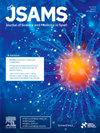在一场公路比赛后,两名经历了中暑的跑步者的核心温度和精神状态。
IF 3
2区 医学
Q1 SPORT SCIENCES
引用次数: 0
摘要
劳役性中暑(EHS)的院前管理包括监测直肠温度(Tre),同时通过冷水浸泡积极冷却。最近的建议是,当Tre不可用时,使用中枢神经系统(CNS)功能障碍来确定是否停止降温。我们检查了两名EHS运动员在公路比赛后的认知反应。这一比较表明,需要谨慎使用这一建议,因为EHS患者的中枢神经系统反应的表现是不可预测的。这两种情况下的变量强调了在为EHS患者降温时避免单独使用精神状态的重要性,并支持在治疗期间将精神状态作为主要临床指标。本文章由计算机程序翻译,如有差异,请以英文原文为准。
Core temperature and mental status of two runners experiencing exertional heat stroke after a road race
Prehospital management of exertional heat stroke (EHS) consists of monitoring rectal temperature (Tre) while aggressively cooling via cold water immersion. Recent recommendations suggest using central nervous system (CNS) dysfunction to determine cessation of cooling when Tre is not available. We examined cognitive responses of two runners with EHS after a road race. This comparison illustrates the need to use caution with this recommendation, as the manifestation of CNS responses in EHS patients can be unpredictable. The variables in both cases highlight the importance of avoiding using mental status alone when cooling EHS patients and support Tre serving as the main clinical indicator during treatment.
求助全文
通过发布文献求助,成功后即可免费获取论文全文。
去求助
来源期刊
CiteScore
7.40
自引率
10.00%
发文量
198
审稿时长
48 days
期刊介绍:
The Journal of Science and Medicine in Sport is the official journal of Sports Medicine Australia (SMA) and is an an international refereed research publication covering all aspects of sport science and medicine.
The Journal considers for publication Original research and Review papers in the sub-disciplines relating generally to the broad sports medicine and sports science fields: sports medicine, sports injury (including injury epidemiology and injury prevention), physiotherapy, podiatry, physical activity and health, sports science, biomechanics, exercise physiology, motor control and learning, sport and exercise psychology, sports nutrition, public health (as relevant to sport and exercise), and rehabilitation and injury management. Manuscripts with an interdisciplinary perspective with specific applications to sport and exercise and its interaction with health will also be considered.

 求助内容:
求助内容: 应助结果提醒方式:
应助结果提醒方式:


